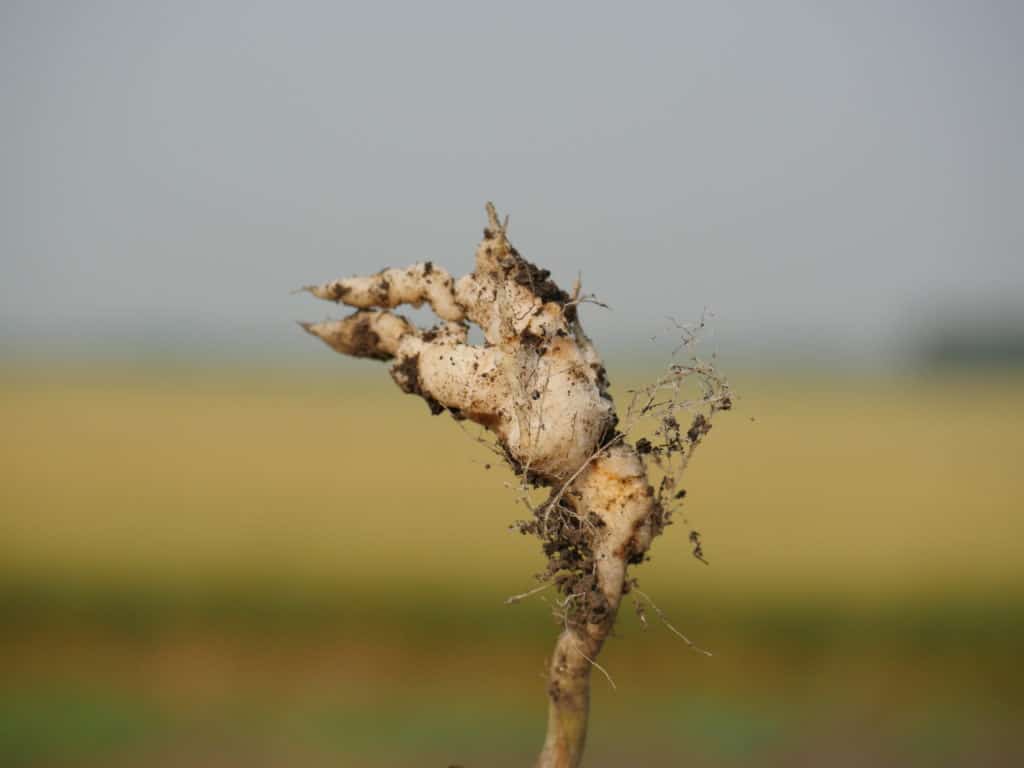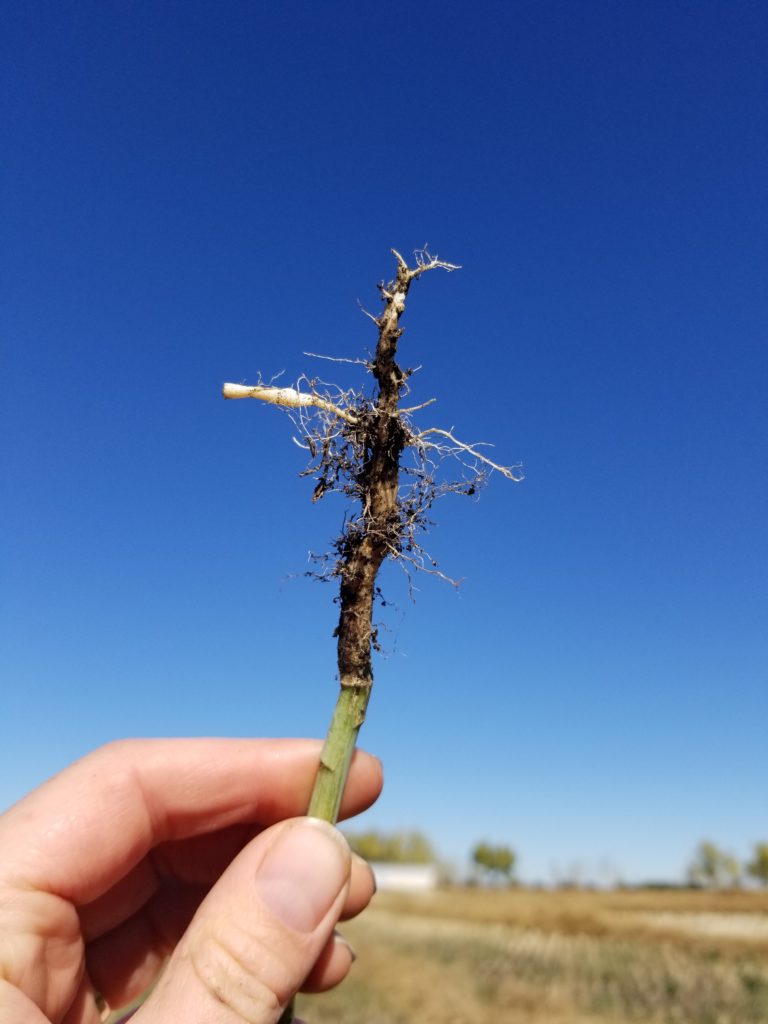The fight against clubroot has evolved over the past few decades since it was discovered in Alberta.
A lot has changed since clubroot was first discovered in Alberta on canola in 2003. While scientists now understand the disease and its necessary management far better today than they did two decades ago, its spread and its genetic diversity means clubroot should be a priority management concern for every Albertan canola producer.
Clubroot brings a two-part challenge. The first challenge is its growing geographic distribution. Clubroot has been spreading fairly consistently from its epicentre in Leduc County. As of 2020, 3,600 Albertan fields had confirmed infestation, with the disease appearing for the first time in 375 new fields.
In 2020, the disease was found for the first time in the Municipal District of Smoky River (Peace region) and in the Counties of Grande Prairie (Peace region) and Wheatland (east of Calgary). While cases have not yet been confirmed in much of southern Alberta, experts caution no part of the province is safe from the disease.
“Not to sound cavalier but, yes, we are expecting to see clubroot continue spreading. There’s really no area that is immune,” says Autumn Barnes, an agronomy specialist and the clubroot lead with the Canola Council of Canada. “The reality is we are spreading soil on equipment and through erosion. Very few people are careful enough with sanitation and biosecurity. When soil moves, clubroot is going to spread too.”
Because it’s so difficult to find this primarily below-ground disease before infestation is widespread, Barnes recommends every Albertan producer grows clubroot resistance (CR) canola in every canola field, as part of a proactive, integrated clubroot management plan.
“It’s about vigilance,” she explains. “All growers need to be really focused on scouting, regardless of whether they’ve had clubroot in their fields. They need to be conscious of crop rotation; they need some sort of biosecurity plan; they need to be managing weeds – mustards, volunteer canola, shepherd’s purse – that can multiply clubroot spores in off-years.”
A 2019 study from the University of Alberta (U of A) showed clubroot in-field spore-load decreased by 90 per cent following a two-year break from canola production. While that drop is very significant and makes rotation a key management strategy, keep in mind a single clubroot gall can produce billions of spores, and spores can last up to 20 years in the soil.
“If you have a billion spores per gram of soil and you wait two years after your last canola rotation, you’re still left with 100 million spores per gram of soil,” Brittany Hennig, Alberta Canola’s research director, explains the two-year wait is done in order to achieve the 90 per cent drop in spore-load. “Clubroot spores are just so plentiful and microscopic that it’s not realistic to say we’re going to eradicate them entirely. The goal is to manage the disease so whatever does remain in your soil doesn’t cause severe infestation in your crop.”
The Growing Resistance Threat
Arguably most critical: all Albertan producers should be exclusively planting resistant varieties. There is still a way to go to achieve that goal — in 2020, 63 per cent of insured canola acres in Alberta were resistant cultivars.
“It’s a good start but our goal is to have (clubroot resistance) in 100 per cent of canola acres. Not all growers understand the importance of having resistance on every acre, regardless of whether they have clubroot in their field or not,” Barnes says. “But we’re moving in the right direction.”
The second concern about clubroot is its increasing ability to overcome a crop’s genetic resistance.
Clubroot that can overcome ‘first generation’ CR was first discovered in Alberta in 2013. To date, 36 different clubroot pathotypes have been identified, 19 of which are able to overcome ‘first-generation’ resistance. In 2017 and 2018 alone, nine new pathotypes of the disease were isolated in the Canadian prairies. As of 2018, clubroot was confirmed to have evaded resistance in 194 fields in Alberta.
While results from samples collected in 2019 and 2020 haven’t yet been released, the trajectory is clear — farmers should expect the disease to continue producing additional resistance-breaking pathotypes. How big a concern is this?
“It’s definitely worrisome,” explains Hennig. “We’re wondering if genetics and breeding can keep up since we know how long it takes to bring a cultivar to market. Farmers don’t need to be scared but they should be proactive and mindful of the disease.”
Seed companies spend millions of dollars and multiple years breeding for resistance. Understandably, they’re protective about the genetics that provide that resistance. ‘First-generation’ resistance was the first resistance unveiled and is effective against the most common clubroot pathotypes.
“First generation CR cultivars are resistant to the same pathotypes and assumed to be derived from the European winter rapeseed cultivar named ‘Mendel’” says Hennig. “Second generation resistance is a lot more complicated: it has the same resistance profile as ‘first generation’, plus something else. So-called ‘second generation’ CR hybrids could have the same or different clubroot resistant sources as each other.”
| Related Articles Clubroot Resistance Breakdown Happening Clubbing Clubroot: An Update On Breeding Clubroot-Resistant Canola New Clubroot Pathotype on the Horizon |
All producers should start managing clubroot by growing a hybrid with ‘first-generation’ resistance.
“Sometimes growers get hung up on the newer product being better. ‘Second-generation’ isn’t necessarily better. So-called ’first-generation’ CR is resistant to the main pathotypes of clubroot and is a good starting point for all farmers. If you see clubroot appearing in ‘first-generation’ CR, lengthen your crop rotation and switch to a second-generation,” says Barnes.
Finding a low level of clubroot in a resistant canola crop doesn’t necessarily mean that the specific disease pathotypes present in your field have overcome your canola hybrid’s genetic resistance. In order to be registered as ‘resistant’, a canola hybrid has to prove an infection rating of 30 per cent or less – both in terms of the number of plants affected and the severity of the disease infection on each plant – compared to a non-resistant hybrid.
“CR varieties are not always 100 per cent resistant. In some cases, the pathotype hasn’t broken resistance: the infection would count as an allowable amount,” says Hennig.
The Clubroot Struggle
Still, it’s always better to be safe than sorry. If clubroot appears on a CR cultivar in your field, it’s always a good idea to send a Ziplock bag of galls away to the U of A for pathotyping.
“Pathotyping may help farmers understand which hybrids to use or avoid. Also, it’s going to help our industry better understand where different pathotypes occur, and if we are seeing new ones in Alberta,” explains Barnes.
While managing clubroot is entirely achievable through integrated management practices, two challenges make this disease more problematic than other common plant pathogens.

First, clubroot symptoms are typically below ground. Scouting requires time-consuming pulling up of plants, right at farmers’ busiest time of year.
“We assume the numbers are much higher than the reporting shows because many cases aren’t identified until the symptoms get really bad,” says Hennig.
Tracking clubroot’s spread is also difficult for an entirely different reason: producers’ reluctance to admit to it.
“There is still a negative stigma around clubroot that prevents farmers from talking about it, unfortunately,” says Hennig. “If I can communicate any message, it’s for people to be a bit more open about it. Lots of farmers now have it. I realize this can be challenging with varying restrictions based on counties/MDs, but if you can talk about it, we can work together to help you figure out ways to manage it properly. Let your neighbours know. Let your retailer/agronomist know. Clubroot can be a very manageable disease.”
Header photo — Finding clubroot when infection isn’t widespread and spore concentrations are low allows more management options. Photo: Canola Council of Canada





